Japanese architect, Kazujo Sejima is known for designs with clean modernist elements such as slick, clean, and shiny surfaces made of glass, marble, and metals. She also uses squares and cubes, which can be found in her designs in various degrees.
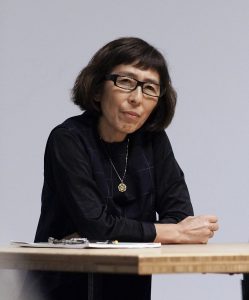
Image source: https://en.wikipedia.org/wiki/Kazuyo_Sejima#/media/File:Canopy_Gathering_Space_(Kazuyo_Sejima)_(15137242547)_cropped.jpg
Who Is Kazujo Sejima?
Kazujo Sejima was born in 1956 in the Prefecture of Ibaraki, Japan and in 1981, after studying at Japan Women’s University, she obtained a master’s degree. Then she started working at the office of Toyo Ito and in 1987 she founded Kazuyo Sejima and Associates. In 1995, she founded the Tokyo-based firm SANAA (Sejima and Nishizawa and Associates) together with her former employee Ryue Nishizawa, an architecture studio that has designed innovative buildings in Japan and around the world. Nishizawa eventually started his own firm two years later, and Sejima maintained hers, but both individual offices were devoted to small-scale projects, in contrast to the ambitious commissions accepted by the partnership.

Image source: https://www.seehosu.com.au/portfolio/sanaa/ Authore(by Krasivaya)
In 2001, both Nishizawa and Sejima took up teaching posts, at Yokohama National University and Tokyo’s Keio University, respectively. About this time they also began to concentrate more on international commissions. In 2005, the pair was selected to design a new branch of the Louvre Museum in Lens, France; the institution opened in 2012. In 2010, Sejima was appointed director of architecture sector for the Venice Biennale, which she curated for the 12th Annual International Architecture Exhibition. She was the first woman ever selected for this position. And the same year, she was awarded the Pritzker Prize, together with Ryue Nishizawa. Kazuyo Sejima and Ryue Nishizawa have worked on several projects in Germany, France, England, the Netherlands, United States, and Spain.
Info source: https://www.stylepark.com/en/designer/kazuyo-sejima
About Sejima’s Most Famous Works
- New Museum of Contemporary Art in New York by Kazuyo Sejima + Ryue
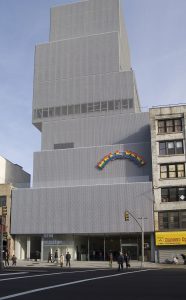
Image source: https://it.wikipedia.org/wiki/New_Museum_of_Contemporary_Art
- Sumida Hokusai Museum in Tokyo
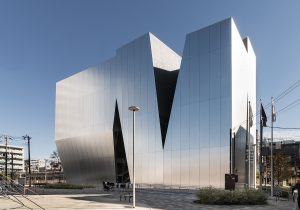
Image source: https://en.wikipedia.org/wiki/Kazuyo_Sejima#/media/File:2018_Sumida_Hokusai_Museum_4.jpg
Designed by the Pritzker Prize for architecture Kazuyo Sejima, the Tokyo museum celebrates the art of Katsushika Hokusai. Built inside the Midori-Cho park, in the neighborhood where the Japanese painter and engraver lived and worked, the Sumida Hokusai Museum marks a new landmark of the city (and is already in the Top 13 of Living of the archistar’s museums). The painter and engraver Hokusai, who lived between 1760 and 1849 and counted among the most famous Japanese artists on an international scale, returns to be an absolute protagonist of the place where he was born and operated. The SANAA duo formed by Kazuyo Sejima and Ryue Nishizawa, winner of the Pritzker Prize in 2010, sign the museum complex. The new building is structured on four floors. The slightly reflecting metallic skin and the angular profile are designed to direct the light in the exhibition halls, where the artist’s work, which loved to portray the waves, is collected on permanent display. Aluminium panels lining the exterior have a mirrored quality that reflects the changing scenes of the surrounding downtown area. In addition to presenting to visitors the creations of the Master and his disciples, the Sumida Hokusai Museum will host temporary exhibitions and events aimed at expressing the link between the district and the artist.
Info source: http://living.corriere.it/city-guide/musei-gallerie/sumida-hokusai-museum-kazuyo-sejima/
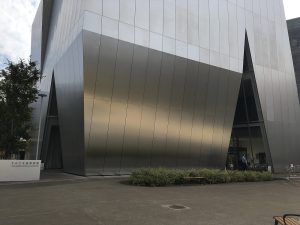
Image source: https://commons.wikimedia.org/wiki/File:2020_Sumida_Hokusai_Museum_02.jpg
What Are The Main Features Of Sejima’s Style?
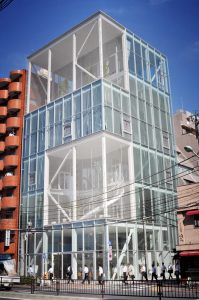
Image source: https://search.creativecommons.org/photos/f0f8c105-4e2a-43b8-ba3d-3042c2a8ce90 by prkbkr
Many of Sejima’s designs like the New Museum in the Bowery District in New York City as well as their Glass Pavilion for the Toledo Museum of Art involve glass and a space open to the world around it. Such design element can be found abundantly in their designs. Sejima creates her designs with clean modernist elements. They usually include slick, clean, and shiny surfaces made of glass, marble, and metals. She also likes to use squares and cubes, which can be found in her designs in various usages. Large windows allow natural light to enter a space, and make her space be involved with the world which is on the other side of the glass. It is this connection of two spaces from which she draws her inspirations. Her early designs already showed the poetic treatment of modern architectural materials and techniques that is the hallmark of her work. Features shared by all these projects include rigorously defined elementary spaces and volumes, and a penchant for glass, aluminium, metal mesh and sculptural surfaces.
Info source: http://www.dreamideamachine.com/en/?p=4180
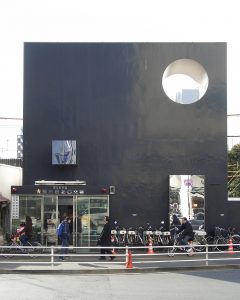
Image source: https://en.wikipedia.org/wiki/Kazuyo_Sejima#/media/File:Chofu_Police_Box.jpg
